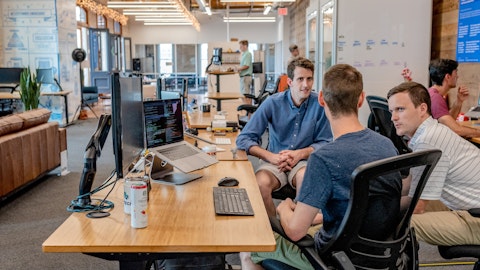Alan Trefler: So we’re seeing both. And happily, we are seeing the innovation budgets starting to come forward. We’ve had with a client actually just yesterday announced they were putting another several hundred million dollars into their innovation budget, which is a great thing to hear from a client that we’re currently selling to. So I think that it will affect some traditional spend for sure, but they’re really looking to make sea changes in their business over the next couple of years, and they’re all not wanting to fall behind.
Jake Roberge: Very helpful. Then Ken, do you still feel Pega is on track to complete the subscription transition this year? And then I know you put out those targets of being a Rule of 40 business as you exit 2024. Given constant currency ACV growth ticked down to 10% this quarter, how should we think about the balance between growth and margin as you look to reach those targets?
Kenneth Stillwell: So we do believe we’ll be done with the subscription transition. In fact, I would even say it go as far as to say we’re really done now. We’ve had a few years where our perpetual license revenue has been under 5% of our total book — sorry, perpetual bookings have been under 5% for now, probably 4 years maybe. And so I think the business has normalized much more. Naturally, we’ll have variability quarter-to-quarter, and you do have the unfortunate accounting of 606. But that said, take that aside, the billings, the consistency of billings, the predictability of billings, that is very much normalized in our business now, Jake. And then when you think about exiting 2024. I mean it certainly looks to us that 2024 would exit with a much higher contribution on the free cash flow than the growth, just even where we are now, naturally, as a Rule of 30-type company, cash flow is higher than our growth rate.
And I think it’s being realistic about where we thought we would land, we always kind of have this model of 15, 25 kind of company was kind of a very nice sustainable model. And so we have a little work to do on the growth side, but I think we’re well on track to actually be kind of mid- to high 20s free cash flow company in 2024. That’s our goal. Naturally, we’re still another quarter away from thinking about our guidance for 2024, but we’ve been very transparent with that’s our objective.
Operator: Our next question comes from Kevin Kumar with Goldman Sachs.
Kevin Kumar: Alan, you called out EMEA in the script. So just curious if you can expand on the health of the customer base in those regions and just the overall kind of macro environment there?
Alan Trefler: Yes. I would say that if you go back a couple of quarters, EMEA was looking a little tepid. I was very pleased with my last visit. And I’m actually coming back there in Q4 because we see things that are set to be done. So I’m seeing a return in most of the countries in EMEA, not all of them. Some of them are still a little tougher, I would say, Germany, for instance. But the U.K. there’s a lot of political stuff going on there, but they’re very interested in trying to figure out how to reframe those businesses to be more profitable.
Kevin Kumar: Great. And then maybe can you give an update on the government vertical, what use cases are you best positioned for? And just in general, the level of deal activity that you’re seeing in that vertical?
Alan Trefler: Yes. We’re seeing a lot of activity in that vertical. And we just hired Jen Pratt, a new senior executive who we announced, who is pushing forward to really, I think, help us be much more effective in that vertical. So I’m very excited, and I love the way she’s coming up to speed, though she’s only been here a couple of months now. What I’ve seen in that vertical is a lot of interest. Our bellwether clients like the IRS and the FBI and Department of Justice, there’s a lot of stuff going on, and there are major needs in those businesses. The use cases we do is we handle serious workflows. But candidly, there are workflows that are kind of pushing tickets around. Those aren’t the Pega workflow. The Pega workflows is where you actually take a meaningful piece of work that has typically a lot of data associated in it and with it that has to live over a long period of time, which is perfect for the government environment.
And that needs a combination of automation, auditing and improve citizen engagement, which is now increasingly top of mind for organizations. So government, not just in the U.S., but when I take a look at what’s going on with some major, major work we’re doing in the U.K., when I look at work we’re actually in Germany, the trip I just took to APAC. We have more than a dozen government systems running in Singapore, for instance. I’m seeing lots of things in every region that make me feel great about what Pega is doing.
Kenneth Stillwell: And just one additional comment on that. If you think about a vertical, so to speak, that is more prone to keep legacy applications plugged in, but be able to try to modernize kind of at the user layer like the — which really feeds well into Pega orchestrating and being able to interact and interface with data set with systems that have maybe embedded in the government, I mean that is a very strong value proposition to be able to improve the customer experience, the applications, modernize, go to cloud, but yet still interact with some of these systems that they really just — the government really just can’t mothball.
Operator: Our next question comes from Rishi Jaluria with RBC.
Rishi Jaluria: Maybe I want to go back to better understanding the macro impact. And more specifically, think about what are customers and partners saying about large-scale digital transformations because as we’ve been hearing from partners that those are things that a lot of customers might be dragging their feet on given the uncertain macro. But simultaneously, I’d have to imagine as companies are contemplating their generative AI strategy, digital transformation to enable that and integrate workflows becomes more and more important. So maybe can you help us understand what you’re seeing in terms of those and kind of weighing the puts and takes about both the near-term macro as well as how customers are kind of trying to position themselves long term to embrace generative AI and your role in enabling that? And then I’ve got a quick follow-up.
Alan Trefler: Sure. So it’s a good question. I would say there are actually a couple of parallel threats to pull on here. So there’s no question when the macro becomes a little more [indiscernible] that organizations want to make sure what they’re really investing in is practical and pragmatic. So they want to make sure what they’re going to see is going to have results. And Pega is very, very well equipped for that environment. We’ve switched ourselves away from the — boy we help you really boost revenue much more to, hey, we’re going to help you make decisions better. We’re going to help you drive workforce better in ways that literally get their work done. So that’s something that I think we’re well suited for. There is a lot of buzz around generative AI.



